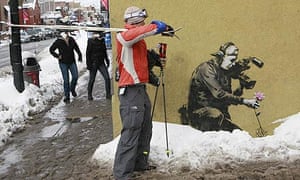By the time the world premiere of Banksy's debut movie, Exit Through the Gift Shop, unfolded at Sundance on Sunday night, the master of mystique had already sprayed his aerosol aura over Park City. Days earlier, five works attributed to the celebrated urban artist had sprung up on walls around town, inspiring ripples of admiration and indignation.
As guerrilla marketing goes it may be a long time before festivalgoers see anything as good as this again. Indeed, the air of mystery remained intact throughout the enterprise, from the moment Exit Through the Gift Shop was unveiled as a surprise screening last week to, well, the end of the movie. Banksy, little surprise, did not attend in person (although he could have strolled into the 446-seat Library Centre Theatre and we would have been none the wiser), choosing instead to send a good-humoured note that invited us to enjoy ourselves.
And we did. Exit Through the Gift Shop is very funny and may well turn out to be the most entertaining movie at the festival. Ostensibly a documentary about Banksy's relationship with an impressionable French film-maker/stalker, the movie highlights that unquenchable thirst among some people for self-expression. It also explores another side of the equation, when the urge turns into rampant self-promotion.
In this regard Exit Through the Gift Shop is a modern-day Frankenstein story. Banksy is the unwitting doctor, who befriends his monster-to-be Thierry Guetta as the latter follows the graffiti god on his artistic escapades. Over time Guetta becomes a kind of assistant on these covert missions and earns Banksy's trust, although he is only allowed to film his subject from behind. Eventually Guetta decides he wants to become an urban artist too. Banksy doesn't protest, and his associate adopts the moniker Mr Brainwash and proceeds to issue forth a diarrhoea of derivative dross that results in a wildly ambitious exhibition in Los Angeles.
The inversion doesn't end there. I don't know anything about how to make a film, Banksy muses, but that didn't stop Thierry. And so he records the preparation of Mr Brainwash's show and in the process strings together a nice potted history of urban art from thousands of hours of footage shot by Guetta before they met. Sitting in shadow and speaking through a voice modifier, Banksy recalls like an ironic Greek chorus the bizarre sequence of events surrounding his peculiar friend. He doesn't show his face, but reveals himself in a far more satisfying way. His droll, mildly bemused commentary, coupled with narration by Rhys Ifans, illustrate the artist in ways that no exclusive unmasking by a media outlet could ever achieve.
The crowd loved it, but we must be careful because this is Sundance, where an audience will muster sustained whoops and applause every time a volunteer scurries across the stage before a screening. However, on this occasion, it seemed genuine. All the major film buyers were in attendance, and it would seem only a matter of time before the story of the quixotic Frenchman and his wry British mentor plays out on a far broader canvas than the screen at the Library Centre Theatre.


View all comments >